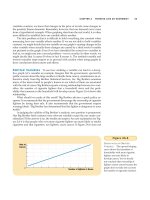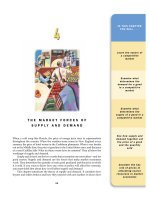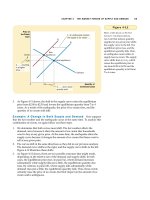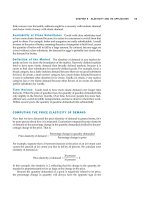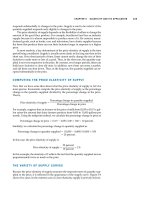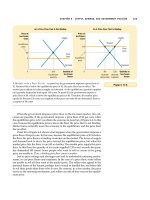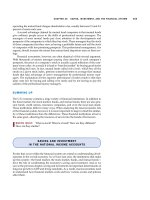Tài liệu Ten Principles of Economics - Part 78 doc
Bạn đang xem bản rút gọn của tài liệu. Xem và tải ngay bản đầy đủ của tài liệu tại đây (220.85 KB, 10 trang )
CHAPTER 34 FIVE DEBATES OVER MACROECONOMIC POLICY 797
October of that year Volcker moved to contract monetary policy to combat the
high rate of inflation that he had inherited from his predecessor. The predictable
result of Volcker’s decision was a recession, and the predictable result of the reces-
sion was a decline in Carter’s popularity. Rather than using monetary policy to
help the president who had appointed him, Volcker helped to ensure Carter’s de-
feat by Ronald Reagan in the November 1980 election.
The practical importance of time inconsistency is also far from clear. Although
most people are skeptical of central-bank announcements, central bankers can
achieve credibility over time by backing up their words with actions. In the 1990s,
the Fed achieved and maintained a low rate of inflation, despite the ever present
temptation to take advantage of the short-run tradeoff between inflation and un-
employment. This experience shows that low inflation does not require that the
Fed be committed to a policy rule.
Any attempt to replace discretion with a rule must confront the difficult task
of specifying a precise rule. Despite much research examining the costs and bene-
fits of alternative rules, economists have not reached a consensus about what a
good rule would be. Until there is a consensus, society has little choice but to give
central bankers discretion to conduct monetary policy as they see fit.
QUICK QUIZ: Give an example of a monetary policy rule. Why might
your rule be better than discretionary policy? Why might it be worse?
SHOULD THE CENTRAL BANK
AIM FOR ZERO INFLATION?
One of the Ten Principles of Economics discussed in Chapter 1, and developed more
fully in Chapter 28, is that prices rise when the government prints too much
money. Another of the Ten Principles of Economics discussed in Chapter 1, and de-
veloped more fully in Chapter 33, is that society faces a short-run tradeoff between
inflation and unemployment. Put together, these two principles raise a question
for policymakers: How much inflation should the central bank be willing to toler-
ate? Our third debate is whether zero is the right target for the inflation rate.
PRO: THE CENTRAL BANK SHOULD
AIM FOR ZERO INFLATION
Inflation confers no benefit on society, but it imposes several real costs. As we dis-
cussed in Chapter 28, economists have identified six costs of inflation:
◆ Shoeleather costs associated with reduced money holdings
◆ Menu costs associated with more frequent adjustment of prices
◆ Increased variability of relative prices
◆ Unintended changes in tax liabilities due to nonindexation of the tax code
798 PART THIRTEEN FINAL THOUGHTS
◆ Confusion and inconvenience resulting from a changing unit of account
◆ Arbitrary redistributions of wealth associated with dollar-denominated debts
Some economists argue that these costs are small, at least for moderate rates of in-
flation, such as the 3 percent inflation experienced in the United States during the
1990s. But other economists claim these costs can be substantial, even for moder-
ate inflation. Moreover, there is no doubt that the public dislikes inflation. When
inflation heats up, opinion polls identify inflation as one of the nation’s leading
problems.
Of course, the benefits of zero inflation have to be weighed against the costs of
achieving it. Reducing inflation usually requires a period of high unemployment
and low output, as illustrated by the short-run Phillips curve. But this disinfla-
tionary recession is only temporary. Once people come to understand that policy-
makers are aiming for zero inflation, expectations of inflation will fall, and the
short-run tradeoff will improve. Because expectations adjust, there is no tradeoff
between inflation and unemployment in the long run.
Reducing inflation is, therefore, a policy with temporary costs and permanent
benefits. That is, once the disinflationary recession is over, the benefits of zero in-
flation would persist into the future. If policymakers are farsighted, they should be
willing to incur the temporary costs for the permanent benefits. This is precisely
the calculation made by Paul Volcker in the early 1980s, when he tightened mone-
tary policy and reduced inflation from about 10 percent in 1980 to about 4 percent
in 1983. Although in 1982 unemployment reached its highest level since the Great
Depression, the economy eventually recovered from the recession, leaving a legacy
of low inflation. Today Volcker is considered a hero among central bankers.
Moreover, the costs of reducing inflation need not be as large as some econo-
mists claim. If the Fed announces a credible commitment to zero inflation, it can
directly influence expectations of inflation. Such a change in expectations can im-
prove the short-run tradeoff between inflation and unemployment, allowing the
economy to reach lower inflation at a reduced cost. The key to this strategy is cred-
ibility: People must believe that the Fed is actually going to carry through on its
announced policy. Congress could help in this regard by passing legislation that
made price stability the Fed’s primary goal. Such a law would make it less costly
to achieve zero inflation without reducing any of the resulting benefits.
One advantage of a zero-inflation target is that zero provides a more natural
focal point for policymakers than any other number. Suppose, for instance, that the
Fed were to announce that it would keep inflation at 3 percent—the rate experi-
enced during the 1990s. Would the Fed really stick to that 3 percent target? If
events inadvertently pushed inflation up to 4 or 5 percent, why wouldn’t they just
raise the target? There is, after all, nothing special about the number 3. By contrast,
zero is the only number for the inflation rate at which the Fed can claim that it
achieved price stability and fully eliminated the costs of inflation.
CON: THE CENTRAL BANK SHOULD NOT
AIM FOR ZERO INFLATION
Although price stability may be desirable, the benefits of zero inflation compared
to moderate inflation are small, whereas the costs of reaching zero inflation are
CHAPTER 34 FIVE DEBATES OVER MACROECONOMIC POLICY 799
large. Estimates of the sacrifice ratio suggest that reducing inflation by 1 percent-
age point requires giving up about 5 percent of one year’s output. Reducing infla-
tion from, say, 4 percent to zero requires a loss of 20 percent of a year’s output. At
the current level of gross domestic product of about $9 trillion, this cost translates
into $1.8 trillion of lost output, which is about $6,500 per person. Although people
might dislike inflation, it is not at all clear that they would (or should) be willing
to pay this much to get rid of it.
The social costs of disinflation are even larger than this $6,500 figure suggests,
for the lost income is not spread equitably over the population. When the econ-
omy goes into recession, all incomes do not fall proportionately. Instead, the
fall in aggregate income is concentrated on those workers who lose their jobs.
The vulnerable workers are often those with the least skills and experience.
Hence, much of the cost of reducing inflation is borne by those who can least af-
ford to pay it.
Although economists can list several costs of inflation, there is no professional
consensus that these costs are substantial. The shoeleather costs, menu costs, and
others that economists have identified do not seem great, at least for moderate
rates of inflation. It is true that the public dislikes inflation, but the public may be
misled into believing the inflation fallacy—the view that inflation erodes living
standards. Economists understand that living standards depend on productivity,
not monetary policy. Because inflation in nominal incomes goes hand in hand with
inflation in prices, reducing inflation would not cause real incomes to rise more
rapidly.
Moreover, policymakers can reduce many of the costs of inflation without ac-
tually reducing inflation. They can eliminate the problems associated with the
nonindexed tax system by rewriting the tax laws to take account of the effects of
inflation. They can also reduce the arbitrary redistributions of wealth between
creditors and debtors caused by unexpected inflation by issuing indexed govern-
ment bonds, as in fact the Clinton administration did in 1997. Such an act insulates
holders of government debt from inflation. In addition, by setting an example, it
might encourage private borrowers and lenders to write debt contracts indexed for
inflation.
Reducing inflation might be desirable if it could be done at no cost, as some
economists argue is possible. Yet this trick seems hard to carry out in practice.
When economies reduce their rate of inflation, they almost always experience a pe-
riod of high unemployment and low output. It is risky to believe that the central
bank could achieve credibility so quickly as to make disinflation painless.
Indeed, a disinflationary recession can potentially leave permanent scars on
the economy. Firms in all industries reduce their spending on new plants and
equipment substantially during recessions, making investment the most volatile
component of GDP. Even after the recession is over, the smaller stock of capital re-
duces productivity, incomes, and living standards below the levels they otherwise
would have achieved. In addition, when workers become unemployed in reces-
sions, they lose valuable job skills. Even after the economy has recovered, their
value as workers is diminished. Some economists have argued that the high un-
employment in many European economies during the past decade is the aftermath
of the disinflations of the 1980s.
Why should policymakers put the economy through a costly, inequitable dis-
inflationary recession to achieve zero inflation, which may have only modest ben-
efits? Economist Alan Blinder, whom Bill Clinton appointed to be vice chairman of
800 PART THIRTEEN FINAL THOUGHTS
the Federal Reserve, argued forcefully in his book Hard Heads, Soft Hearts that
policymakers should not make this choice:
The costs that attend the low and moderate inflation rates experienced in the
United States and in other industrial countries appear to be quite modest—more
like a bad cold than a cancer on society. . . . As rational individuals, we do not
volunteer for a lobotomy to cure a head cold. Yet, as a collectivity, we routinely
prescribe the economic equivalent of lobotomy (high unemployment) as a cure
for the inflationary cold.
Blinder concludes that it is better to learn to live with moderate inflation.
QUICK QUIZ: Explain the costs and benefits of reducing inflation to zero.
Which are temporary and which are permanent?
SHOULD FISCAL POLICYMAKERS
REDUCE THE GOVERNMENT DEBT?
Perhaps the most persistent macroeconomic debate in recent years has been over
the finances of the federal government. Throughout most of the 1980s and 1990s,
the U.S. federal government spent more than it collected in tax revenue and fi-
nanced this budget deficit by issuing government debt. When we studied financial
markets in Chapter 25, we saw how budget deficits affect saving, investment, and
interest rates.
This situation reversed itself in the late 1990s, when a combination of tax hikes,
spending cuts, and strong economic growth eliminated the government’s budget
deficit and even produced a small budget surplus. Our fourth debate concerns
whether fiscal policymakers should use this budget surplus to reduce the govern-
ment debt. The alternative is to eliminate the budget surplus by cutting taxes or
increasing spending.
PRO: POLICYMAKERS SHOULD
REDUCE THE GOVERNMENT DEBT
The U.S. federal government is far more indebted today than it was two decades
ago. In 1980, the federal debt was $710 billion; in 1999, it was $3.7 trillion. If we di-
vide today’s debt by the size of the population, we learn that each person’s share
of the government debt is about $14,000.
The most direct effect of the government debt is to place a burden on future
generations of taxpayers. When these debts and accumulated interest come due,
future taxpayers will face a difficult choice. They can pay higher taxes, enjoy less
government spending, or both, in order to make resources available to pay off the
debt and accumulated interest. Or they can delay the day of reckoning and put the
government into even deeper debt by borrowing once again to pay off the old debt
and interest. In essence, when the government runs a budget deficit and issues
government debt, it allows current taxpayers to pass the bill for some of their
“MY SHARE OF THE GOVERNMENT DEBT
IS
$14,000.”
CHAPTER 34 FIVE DEBATES OVER MACROECONOMIC POLICY 801
government spending on to future taxpayers. Inheriting such a large debt cannot
help but lower the living standard of future generations.
In addition to this direct effect, budget deficits also have various macroeco-
nomic effects. Because budget deficits represent negative public saving, they lower
national saving (the sum of private and public saving). Reduced national saving
causes real interest rates to rise and investment to fall. Reduced investment leads
over time to a smaller stock of capital. A lower capital stock reduces labor produc-
tivity, real wages, and the economy’s production of goods and services. Thus,
when the government increases its debt, future generations are born into an econ-
omy with lower incomes as well as higher taxes.
There are, nevertheless, situations in which running a budget deficit is justifi-
able. Throughout history, the most common cause of increased government debt is
war. When a military conflict raises government spending temporarily, it is rea-
sonable to finance this extra spending by borrowing. Otherwise, taxes during
wartime would have to rise precipitously. Such high tax rates would greatly dis-
tort the incentives faced by those who are taxed, leading to large deadweight
losses. In addition, such high tax rates would be unfair to current generations of
taxpayers, who already have to make the sacrifice of fighting the war.
Similarly, it is reasonable to allow a rise in government debt during a tempo-
rary downturn in economic activity. When the economy goes into a recession, tax
revenue falls automatically, because the income tax and the payroll tax are levied
on measures of income. If the government tried to balance its budget during a re-
cession, it would have to raise taxes or cut spending at a time of high unemploy-
ment. Such a policy would tend to depress aggregate demand at precisely the time
it needed to be stimulated and, therefore, would tend to increase the magnitude of
economic fluctuations.
The rise in government debt during the 1980s and 1990s, however, cannot be
justified by appealing to war or recession. During this period, the United States
avoided major military conflict and major economic downturn. Nonetheless, the
government consistently ran a budget deficit, largely because the president and
Congress found it easier to increase government spending than to increase taxes.
As a result, government debt as a percentage of annual gross domestic product in-
creased from 26 percent in 1980 to 50 percent in 1995, before falling back a bit to
44 percent in 1999. It is hard to see any rationale for this rise in government debt.
If the U.S. government had been operating with a balanced budget since 1980,
today’s college graduates would be entering an economy that promised them
greater economic prosperity.
It’s now time to reverse the effects of this policy mistake. A combination of
fiscal prudence and good luck left the U.S. government with a budget surplus in
the late 1990s and projected surpluses for subsequent years. We should use these
surpluses to repay some of the debt that the government has accumulated. Com-
pared to the alternative of cutting taxes or increasing spending, repaying the debt
would mean greater national saving, investment, and economic growth.
CON: POLICYMAKERS SHOULD NOT
REDUCE THE GOVERNMENT DEBT
The problem of government debt is often exaggerated. Although the government
debt does represent a tax burden on younger generations, it is not large compared
to the average person’s lifetime income. The debt of the U.S. federal government is
802 PART THIRTEEN FINAL THOUGHTS
about $14,000 per person. A person who works 40 years for $25,000 a year will earn
$1 million over his lifetime. His share of the government debt represents less than
2 percent of his lifetime resources.
Moreover, it is misleading to view the effects of government debt in isolation.
The government debt is just one piece of a large picture of how the government
chooses to raise and spend money. In making these decisions over fiscal policy,
policymakers affect different generations of taxpayers in many ways. The govern-
ment’s budget deficit or surplus should be considered together with these other
policies.
For example, suppose the government uses the budget surplus to pay off the
government debt instead of using it to pay for increased spending on education.
Does this policy make young generations better off? The government debt will be
smaller when they enter the labor force, which means a smaller tax burden. Yet if
they are less well educated than they could be, their productivity and incomes will
be lower. Many estimates of the return to schooling (the increase in a worker’s
wage that results from an additional year in school) find that it is quite large. Re-
ducing the government debt rather than funding more education spending could,
all things considered, make future generations worse off.
Single-minded concern about the government debt is also dangerous because
it draws attention away from various other policies that redistribute income across
generations. For example, in the 1960s and 1970s, the U.S. federal government
raised Social Security benefits for the elderly. It financed this higher spending by
increasing the payroll tax on the working-age population. This policy redistributed
income away from younger generations toward older generations, even though
it did not affect the government debt. Thus, government debt is only a small
piece of the larger issue of how government policy affects the welfare of different
generations.
To some extent, the adverse effects of government debt can be reversed by
forward-looking parents. Suppose a parent is worried about the impact of the
government debt on his children. The parent can offset the impact simply by sav-
ing and leaving a larger bequest. The bequest would enhance the children’s ability
to bear the burden of future taxes. Some economists claim that people do in fact
behave this way. If this were true, higher private saving by parents would offset
the public dissaving of budget deficits, and deficits would not affect the economy.
Most economists doubt that parents are so farsighted, but some people probably
do act this way, and anyone could. Deficits give people the opportunity to con-
sume at the expense of their children, but deficits do not require them to do so. If
the government debt actually represented a great problem facing future genera-
tions, some parents would help to solve it.
Critics of budget deficits sometimes assert that the government debt cannot
continue to rise forever, but in fact it can. Just as a bank officer evaluating a loan
application would compare a person’s debts to his income, we should judge the
burden of the government debt relative to the size of the nation’s income. Popula-
tion growth and technological progress cause the total income of the U.S. economy
to grow over time. As a result, the nation’s ability to pay the interest on the gov-
ernment debt grows over time as well. As long as the government debt grows
more slowly than the nation’s income, there is nothing to prevent the government
debt from growing forever.
Some numbers can put this into perspective. The real output of the U.S. econ-
omy grows on average about 3 percent per year. If the inflation rate is 2 percent per
CHAPTER 34 FIVE DEBATES OVER MACROECONOMIC POLICY 803
WHEN POLICYMAKERS FACE GOVERNMENT
budget surpluses, they have three op-
tions: cutting taxes, increasing spend-
ing, or reducing the government debt.
Choosing is not easy.
Lawmakers Discover
That Surpluses
Can Be as Vexing as Deficits
BY DAVID WESSEL AND GREG HITT
WASHINGTON—It took politicians 15 con-
tentious years to eliminate the biggest
federal budget deficits since World
War II. Now, they are having nearly as
much difficulty deciding what to do with
the roughly $3 trillion in surpluses pro-
jected over the next 10 years.
The sudden emergence of a budget
windfall larger than anticipated just six
months ago is forcing into fast-forward
a longstanding debate over fiscal policy
and the role of government.
On the surface, lawmakers face a
simple multiple-choice question: Should
the surplus be saved, spent, or devoted
to tax cuts? But at its core, the debate
is about profound issues that were
long suppressed by the deficit-reduction
imperative:
How big should government be?
Do Americans prefer to pay less in
taxes or have government do more?
How much should younger workers sac-
rifice to support baby-boomer parents
and grandparents in retirement, and how
much should baby-boomers set aside in
advance? How much should government
interfere with the workings of the market
to spread the benefits of today’s pros-
perity? Is paying off debt incurred in the
1980s and 1990s more or less important
than raising spending on education and
health or lowering taxes?
With something less than unanimity,
Republicans make the case for bigger
tax cuts and smaller government. “Re-
publicans believe it’s a matter of principle
to return excess tax money in Wash-
ington to the families and workers who
sent it here,” House Ways and Means
Chairman Bill Archer, a Texas Republi-
can, said on the floor of the House of
Representatives during last week’s tax-
cut debate. “Republicans believe that
Americans have the right to keep more
of what they earn.”
Where Republicans see an over-
taxed populace, however, liberal Democ-
rats in Congress see “unmet needs.”
“The question,” says Rep. Barney
Frank, a Massachusetts Democrat, “is
not whether the surplus should be spent
according to people’s wishes. Of course
it should. The question is whether it
should be spent on private goods or
public goods.” . . .
The public is split, but a new Wall
Street Journal/NBC News poll suggests
that the GOP is having trouble selling
its call for tax cuts. . . . Asked to pick
just one option for using the surplus, 46
percent of the 1,007 respondents opted
for spending on social programs such as
education or a prescription-drug benefit
for Medicare recipients, 22 percent
picked paying down the federal debt, and
only 20 percent picked tax cuts. (The
rest picked defense or didn’t make a
choice.)
“We are not in a period like the
late 1970s when people really despised
government,” says Republican pollster
Robert Teeter, who conducted the poll
with Democrat Peter Hart. “The elec-
torate is saying there are serious le-
gitimate issues that the government
should address, and they are willing to
use some of their money to do it,” Mr.
Teeter adds. . . .
Fed Chairman Greenspan continues
to preach the virtues of debt reduction.
Although he doesn’t admit to as much,
he sees virtue in gridlock. If Congress
and Mr. Clinton can get appropriations
bills enacted this year, but agree on
nothing else, then the surplus will auto-
matically go to reducing the government
debt.
SOURCE: The Wall Street Journal, July 29, 1999,
p. A1.
IN THE NEWS
The Budget Surplus
804 PART THIRTEEN FINAL THOUGHTS
year, then nominal income grows at a rate of 5 percent per year. The government
debt, therefore, can rise by 5 percent per year without increasing the ratio of debt
to income. In 1999 the federal government debt was $3.7 trillion; 5 percent of this
figure is $165 billion. As long as the federal budget deficit is smaller than $165 bil-
lion, the policy is sustainable. There will never be any day of reckoning that forces
the budget deficits to end or the economy to collapse.
If moderate budget deficits are sustainable, there is no need for the govern-
ment to maintain budget surpluses. Let’s put this excess of revenue over spending
to better use. The government could use these funds to pay for valuable govern-
ment programs, such as increased funding for education. Or it could use them to
finance a tax cut. In the late 1990s taxes reached an historic high as a percentage of
GDP, so there is every reason to suppose that the deadweight losses of taxation
reached an historic high as well. If all these taxes aren’t needed for current spend-
ing, the government should return the money to the people who earned it.
QUICK QUIZ: Explain how reducing the government debt makes future
generations better off. What fiscal policy might improve the lives of future
generations more than reducing the government debt?
SHOULD THE TAX LAWS BE REFORMED TO
ENCOURAGE SAVING?
A nation’s standard of living depends on its ability to produce goods and services.
This was one of the Ten Principles of Economics in Chapter 1. As we saw in Chapter
24, a nation’s productive capability, in turn, is determined largely by how much it
saves and invests for the future. Our fifth debate is whether policymakers should
reform the tax laws to encourage greater saving and investment.
PRO: THE TAX LAWS SHOULD BE
REFORMED TO ENCOURAGE SAVING
A nation’s saving rate is a key determinant of its long-run economic prosperity.
When the saving rate is higher, more resources are available for investment in new
plant and equipment. A larger stock of plant and equipment, in turn, raises labor
productivity, wages, and incomes. It is, therefore, no surprise that international
data show a strong correlation between national saving rates and measures of eco-
nomic well-being.
Another of the Ten Principles of Economics presented in Chapter 1 is that people
respond to incentives. This lesson should apply to people’s decisions about how
much to save. If a nation’s laws make saving attractive, people will save a higher
fraction of their incomes, and this higher saving will lead to a more prosperous
future.
Unfortunately, the U.S. tax system discourages saving by taxing the return to
saving quite heavily. For example, consider a 25-year-old worker who saves $1,000
CHAPTER 34 FIVE DEBATES OVER MACROECONOMIC POLICY 805
of her income to have a more comfortable retirement at the age of 70. If she buys a
bond that pays an interest rate of 10 percent, the $1,000 will accumulate at the end
of 45 years to $72,900 in the absence of taxes on interest. But suppose she faces a
marginal tax rate on interest income of 40 percent, which is typical of many work-
ers once federal and state income taxes are added together. In this case, her after-
tax interest rate is only 6 percent, and the $1,000 will accumulate at the end of 45
years to only $13,800. That is, accumulated over this long span of time, the tax rate
on interest income reduces the benefit of saving $1,000 from $72,900 to $13,800—
or by about 80 percent.
The tax code further discourages saving by taxing some forms of capital in-
come twice. Suppose a person uses some of his saving to buy stock in a corpora-
tion. When the corporation earns a profit from its capital investments, it first pays
tax on this profit in the form of the corporate income tax. If the corporation pays
out the rest of the profit to the stockholder in the form of dividends, the stock-
holder pays tax on this income a second time in the form of the individual income
tax. This double taxation substantially reduces the return to the stockholder,
thereby reducing the incentive to save.
The tax laws again discourage saving if a person wants to leave his accumu-
lated wealth to his children (or anyone else) rather than consuming it during his
lifetime. Parents can bequeath some money to their children without tax, but if the
bequest becomes large, the inheritance tax rate can be as high as 55 percent. To a
large extent, concern about national saving is motivated by a desire to ensure eco-
nomic prosperity for future generations. It is odd, therefore, that the tax laws dis-
courage the most direct way in which one generation can help the next.
In addition to the tax code, many other policies and institutions in our society
reduce the incentive for households to save. Some government benefits, such as
welfare and Medicaid, are means-tested; that is, the benefits are reduced for those
who in the past have been prudent enough to save some of their income. Colleges
and universities grant financial aid as a function of the wealth of the students and
their parents. Such a policy is like a tax on wealth and, as such, discourages stu-
dents and parents from saving.
There are various ways in which the tax code could provide an incentive to
save, or at least reduce the disincentive that households now face. Already the tax
laws give preferential treatment to some types of retirement saving. When a tax-
payer puts income into an Individual Retirement Account (IRA), for instance, that
income and the interest it earns are not taxed until the funds are withdrawn at re-
tirement. The tax code gives a similar tax advantage to retirement accounts that go
by other names, such as 401(k), 403(b), Keogh, and profit-sharing plans. There are,
however, limits to who is eligible to use these plans and, for those who are eligible,
limits on the amount that can be put in them. Moreover, because there are penal-
ties for withdrawal before retirement age, these retirement plans provide little in-
centive for other types of saving, such as saving to buy a house or pay for college.
A small step to encourage greater saving would be to expand the ability of house-
holds to use such tax-advantaged savings accounts.
A more comprehensive approach would be to reconsider the entire basis by
which the government collects revenue. The centerpiece of the U.S. tax system is
the income tax. A dollar earned is taxed the same whether it is spent or saved.
An alternative advocated by many economists is a consumption tax. Under a
consumption tax, a household pays taxes only on the basis of what it spends.
Income that is saved is exempt from taxation until the saving is later withdrawn
806 PART THIRTEEN FINAL THOUGHTS
and spent on consumption goods. In essence, a consumption tax puts all sav-
ing automatically into a tax-advantaged savings account, much like an IRA. A
switch from income to consumption taxation would greatly increase the incentive
to save.
CON: THE TAX LAWS SHOULD
NOT BE REFORMED TO ENCOURAGE SAVING
Increasing saving may be desirable, but it is not the only goal of tax policy. Policy-
makers also must be sure to distribute the tax burden fairly. The problem with pro-
posals to increase the incentive to save is that they increase the tax burden on those
who can least afford it.
It is an undeniable fact that high-income households save a greater fraction of
their income than low-income households. As a result, any tax change that favors
people who save will also tend to favor people with high income. Policies such
as tax-advantaged retirement accounts may seem appealing, but they lead to a
less egalitarian society. By reducing the tax burden on the wealthy who can take
advantage of these accounts, they force the government to raise the tax burden on
the poor.
Moreover, tax policies designed to encourage saving may not be effective at
achieving that goal. Many studies have found that saving is relatively inelastic—
that is, the amount of saving is not very sensitive to the rate of return on saving.
If this is indeed the case, then tax provisions that raise the effective return by
reducing the taxation of capital income will further enrich the wealthy without
inducing them to save more than they otherwise would.
Economic theory does not give a clear prediction about whether a higher
rate of return would increase saving. The outcome depends on the relative size
of two conflicting effects, called the substitution effect and the income effect. On
the one hand, a higher rate of return raises the benefit of saving: Each dollar
saved today produces more consumption in the future. This substitution effect
tends to raise saving. On the other hand, a higher rate of return lowers the need
for saving: A household has to save less to achieve any target level of consumption
in the future. This income effect tends to reduce saving. If the substitution and
income effects approximately cancel each other, as some studies suggest, then
saving will not change when lower taxation of capital income raises the rate of
return.
There are other ways to raise national saving than by giving tax breaks to the
rich. National saving is the sum of private and public saving. Instead of trying to
alter the tax code to encourage greater private saving, policymakers can simply
raise public saving by increasing the budget surplus, perhaps by raising taxes on
the wealthy. This offers a direct way of raising national saving and increasing pros-
perity for future generations.
Indeed, once public saving is taken into account, tax provisions to encourage
saving might backfire. Tax changes that reduce the taxation of capital income
reduce government revenue and, thereby, lead to a budget deficit. To increase na-
tional saving, such a change in the tax code must stimulate private saving by more
than it reduces public saving. If this is not the case, so-called saving incentives can
potentially make matters worse.
